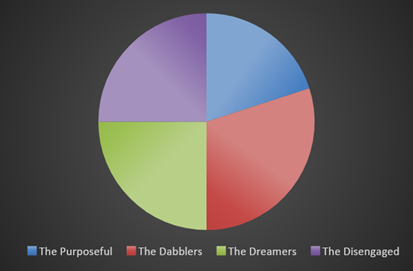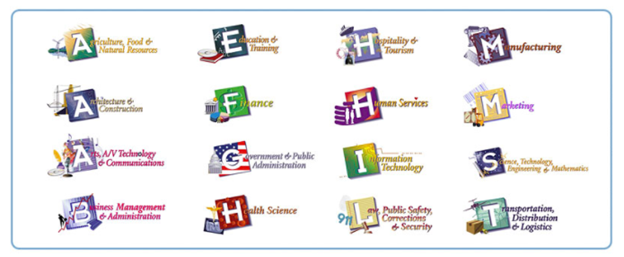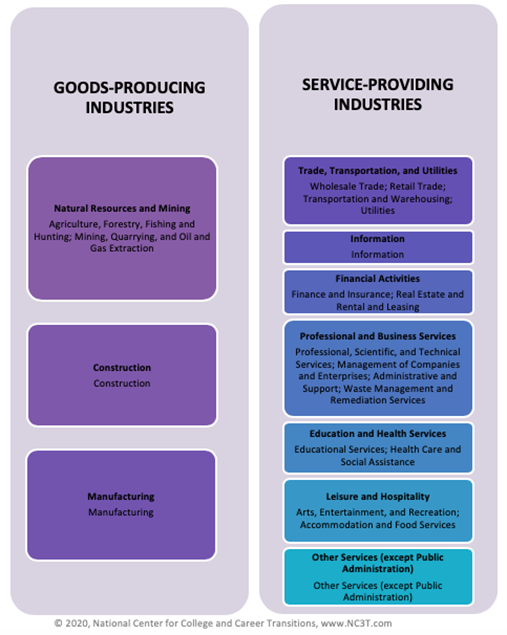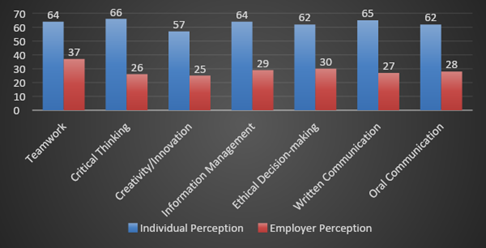No products in the cart.
Career Exploration Lesson Plan #1: Getting Started on Your Career Journey
Lesson Overview
This lesson introduces students to the world of work through the foundational career exploration concepts of career clusters and industry sectors.
There are three main components to this lesson plan, including resources. Click the links below to navigate to the specific components of the lesson, Reading, Deliverables, and Resources, or scroll through to access each component sequentially.
Reading
One of the major shortcomings in U.S. education is the lack of substantive and impactful career development to help you make aspirational and realistic career choices. Even though approximately 30 states have some formal requirements for career development in middle schools and high schools, for many young people, implementation of these requirements is lacking. Still, most students do not receive a career development experience that makes a significant impact to inform their career decisions and equip them to make informed decisions.
Further, even though most colleges and many adult-serving programs offer career services, rarely is career development held up as an essential or non-negotiable step to moving forward in a program. Even when career services are accessed, the process may be fast-tracked or short-circuited. This can lead to disconnection or disengagement.
The Disengaged

The Purposeful: Found something meaningful, sustained interest, and a clear sense of future purpose.
The Dabblers: Tried potentially purposeful pursuits, yet to commit.
The Dreamers: Imagining great things, no practical pursuits.
The Disengaged: Neither a purpose in life nor an inclination to find one.
(Benson, P., 2008; Damon, W., 2008)
In Module 1, we discuss how too many people find themselves disconnected and disengaged. When we ask why, we discover three underlying challenges yielding career path confusion. Those challenges are:
- Most school systems (and colleges) don’t deliver impactful career development.
- Most school systems (and colleges) don’t connect you with meaningful employer experiences.
- Most school systems explicitly or subtly promote a generic “4-year college for all” philosophy as the only path to success.
Unpacking the Challenges
CHALLENGE #1: Most school systems (and colleges) don’t deliver impactful career development.
Today’s youth face several well-documented critical challenges that are national trends. These trends pose challenges to our nation’s economy and overall way of life and can be organized into Visible Challenges and Root Problems according to The Power and Promise of Pathways (Meeder, H., 2016). Visible Challenges include the skills gap (too few skilled workers and slow growth), the entrepreneurship gap, shrinking workforce participation, youth not working and not going to school, youth not completing postsecondary education, the slipping competitiveness of the U.S. workforce, and economic setbacks facing young adults (p. 30).
Visible Challenges indicate Root Problems – the root causes that we don’t easily see that lead to these visible issues that capture our attention. Our three underlying challenges are part of the root: the dearth of impactful Career Development, an absence of employer-student connectedness, and a dominant, “’university for all’ message” (2016, p. 39).
Although schools share career planning responsibility with others (primarily parents), in a Harris poll in 2015, more than half (51%) of students said that “no one” from the high school was helping with advice on career options to further their education (McCleary, et al., 2015). A similar report from the 2015 Youth Truth Survey provided additional statistics on student perception that schools fall short:
| My high school helped me… |
Respondents who said “Agree” |
| To discover personal career interests and aptitudes |
46% |
| To understand the steps needed to pursue a career |
49% |
| To develop knowledge and skills needed for college-level classes |
60% |
| To know how to apply for college admissions |
56% |
CHALLENGE #2: Most school systems (and colleges) don’t connect students with meaningful employer experiences.
While meaningful employer experiences for students often has great impact on future career choice, learners experience a disconnect with the World of Work. In a poll conducted by McGraw Hill, only 20 percent of college students said they felt very well prepared for the workforce (Noe, R., & Kodwani, A., 2018). In the same poll by McGraw Hill and published by the U.S. Department of Education (NCES Table H173), additional low percentages of participation in meaningful work-based learning experiences exist.

(Noe, R. & Kodwani, A., 2018)
Perhaps some examples of work-based learning would help make sense of this information and how you can increase your own employer experiences.
- Take an introductory-level class in a designated Career Cluster or major
- Meet with a faculty advisor to discuss careers connecting to a major
- Find out which local, regional, and national companies hire people in your chosen field
- Attend meetings of career-related clubs and student activities
- Seek opportunities for job shadows (3-4 hours) or micro-internships (10-15 hours) to further expand your career exploration experience
- Pursue semester-based Internships and inter-semester cooperative education placements
- Work on a capstone project focused on your area(s) of interest
- Work on an entrepreneurial project or join a student-run business
- Secure part-time employment during the school year to develop workplace skills and networking opportunities
- Take relevant skills-based certification exams
- Develop a portfolio document which captures information about your assessments, skills, certification, and work products …anything you developed through coursework, skills competitions, or internships is fair game
- Any other experience where you have or are learning through active participation in a career-related role (e.g. your family’s business)
These work-based learning experiences are squarely situated in the World of Work, but what do we mean by “The World of Work?” In order to organize the World of Work in an easy-to-understand manner, CareerSmart Schools uses two frameworks: Career Clusters is the first. The National Center for Technical Education developed a National Model of 16 Career Clusters to organize the jobs people do by their work tasks.

 In unpacking the World of Work completely, however, it’s not enough simply to categorize the work people do into Career Clusters. We must also consider this work in the context where it is done: We call these Industry Sectors and, in the U.S., we organize them into two categories: Goods and Services.
In unpacking the World of Work completely, however, it’s not enough simply to categorize the work people do into Career Clusters. We must also consider this work in the context where it is done: We call these Industry Sectors and, in the U.S., we organize them into two categories: Goods and Services.
So, in order to understand the World of Work, you need to know that Career Clusters organize WHAT each career does and Industry Sectors help us organize WHERE the work is done. Why is this important? Remember our second underlying challenge that leads people down a road of confusion when asked about their career path: Most school systems (and colleges) don’t connect students with meaningful employer experiences. CareerSmart Schools aims to correct that by helping you understand where you might best connect to the World of Wok and then preparing you to make these connections – the consequences of the disconnect are just too great.
One of the largest disconnects involves student perceptions of preparedness with regard to important Employability Skills needed to be successful in the World of Work. In a 2015 Harris poll, both employers and recent college graduates were asked to evaluate recently hired employees regarding how well prepared they were to apply important cross-cutting skills. Across the board, the recent graduates expressed a greater sense of confidence in their own readiness than did their employers. The following examples demonstrate the disconnect in perceptions between recent college graduates and their employers – a disconnect that could be lessened with work-based learning experiences in school.
The Disconnect

|
EMPLOYABILITY SKILL |
READINESS |
|
| I can… |
Individual Perception |
Employer Perception |
| …work with others in teams. |
64% |
37% |
| …analyze/think critically. |
66% |
26% |
| …be creative and innovative. |
57% |
25% |
| …locate, organize, and evaluate information. |
64% |
29% |
| …make decisions and exercise ethical judgment. |
62% |
30% |
| …utilize good written communication skills. |
65% |
27% |
| …utilize good oral communication skills. |
62% |
28% |
The message from this chart is that a significant disconnect exists between employers and recently hired youth. Reconciling the perception gap is critical to workplace success. It’s not enough to simply address the gap in perceptions relative to Employability Skills. We’ll work on this learning target in a later module.
Unpacking the Challenges
UNDERLYING CHALLENGE #3: Most school systems explicitly or subtly promote a generic “4-year college for all” philosophy as the only path to success.

This mistaken one-size-fits-all philosophy is promoted by charts like the one above, however, according to Kevin Fleming in 4 Skills + 4 Steps to a Successful Career (2020), the “college for all” rhetoric that these charts promote must be replaced by a “postsecondary credential for all.” Academic knowledge and technical skills are the combination most sought by employers: “One without the other is no longer enough. Having both, makes you more employable.” CareerSmart Schools will help you understand and access the many postsecondary paths to help you gain both academic knowledge and technical skills. We’ll discuss this further in a future module. For now, the earnings numbers may surprise you:

- 43% of workers with a license or certificate earn more than workers with an Associate degree.
- 27% of workers with a license or certificate earn more than workers with a Bachelor’s degree.
- 31% of workers who hold an Associate degree earn more than individuals with a Bachelor’s degree.
In Career Connected Learning, all learners experience meaningful and expansive career development that focuses on the right path for the individual, based on self-discovery. Parents or guardians are actively engaged in the process. A well-planned career development program encourages students to
- Identify personal aptitudes and interests
- Explore career options through multiple methods
- Make informed postsecondary education and training decisions.
In Conclusion
Students and young adults need and deserve exposure to career development information and experiences so that they can make sound decisions for their future. This starts with you! While career counselors and coaches hold special expertise in career development, the fact is that teachers and faculty have a more sustained relationship with the student. Thus, career development for every student should be a principle that is shared across the campus or adult education program, and that is incorporated into classroom instruction, as well as part of admissions and student support services.
Career Development is more than an obligation to you – it’s an important opportunity to help each student enrolled in our college and adult education programs to discover more about themselves, more about the world of career opportunities that await, and to hone the career navigation skills they need for short-term and long-term success.
In the K-12 system, career development efforts can begin early, intensify in the middle school years, and become even more focused during high school. Ideally, postsecondary partners utilize an aligned career development framework for their adult learners. Career development should be much more than having a student complete an interest inventory, write down career goals, select a college major or degree objective, or even create a course schedule loosely based on an identified career interest. That’s why CareerSmart Schools is so much more.
In CareerSmart Schools, you’ll proceed through the four steps of Career Development: Career Awareness, Career Exploration & Self-Discovery, Career Preparation & Immersion, and Career Management.
Career Exploration Lesson Pan #1 Deliverables
In PowerPoint 1A, you will walk students through the beginning stages of career exploration as they learn about career development and the world of work, categorized into career clusters and industry sectors.
In PowerPoint 1B, you will help students dive deeper into the 16 career clusters and various industry sectors. This will highlight for students that career clusters are what work you do, and industry sectors are where you do your work. Establishing this foundational knowledge and understanding of these key concepts are a critical launching pad for further career exploration.
At the end of PowerPoints 1A & 1B, students will be asked to complete an activity that breaks down the four stages of career development and documents their career cluster and industry sector interests. This activity will help solidify their understanding of these concepts as they prepare to Show What You Know in this lesson’s short quiz.
Click the buttons below to download both PowerPoint presentations, the activity sheet, and the Show What You Know quiz.
Deliverable Downloads
Resources
Web Resources
16 career clusters pdf—Google Search. (n.d.). Retrieved April 4, 2020. Click here.
Are you getting relationships right? (n.d.). Create a Deeper Relationship with Kids Who Need It Most. View Kent Pekel’s TEDx Talk, Getting Relationships Right. And Download the 4S Interview Tool, as Well as Discussion Questions.#relationships #youthdevelopment. Retrieved April 5, 2020, click here.
Careers and career information—Careeronestop. (n.d.). Retrieved April 5, 2020, click here.
Contributor, M. B. (2019, May 7). Graduating in 2019? These 3 tiny yet powerful mindset shifts will set you up for rapid success. CNBC. Click here.
Defense, D. of. (n.d.). My future | career, college, military. Retrieved April 5, 2020, click here.
Home | advance cte. (n.d.). Retrieved April 5, 2020, click here.
Home: Occupational outlook handbook: : u. S. Bureau of labor statistics. (n.d.). Retrieved April 5, 2020, click here.
K-12: U. S. Bureau of labor statistics. (n.d.). Retrieved April 5, 2020, click here.
Livecareer: Professional resume services from the experts. (n.d.). LiveCareer. Retrieved April 5, 2020, click here.
O*net online. (n.d.). Retrieved April 18, 2020, click here.
Roadtrip nation. (n.d.). Retrieved April 5, 2020, click here.
Salary comparison by job—Salaries by city. (n.d.). CareerBuilder. Retrieved April 5, 2020, click here.
The 100 Best Jobs of 2020. (n.d.). Retrieved April 5, 2020, click here.
Ward, M. (2017, April 20). 7 ways your mindset is derailing your career—And how to change it. CNBC. Click here.
Youtube. (n.d.-a). 4 Skills + 4 Steps to a Successful Career. Retrieved April 4, 2020, click here.
Youtube. (n.d.-b). Georgetown University Center on Education and the Workforce. Retrieved April 4, 2020, click here.
Youtube. (n.d. -c). Growth Mindset. Retrieved April 18, 2020, click here.
Print Resources
Benson, P. L. (2008). Sparks: How parents can ignite the hidden strengths of teenagers. John Wiley & Sons.
Damon, William. (2008). The path to purpose: Helping our children find their calling in life. 1st Free Press hardcover ed, Free Press.
Meeder, H. (2020, March 31). The essentials of Career Smart Parenting: How to help children think about their future [PowerPoint slides]. Google.
Meeder, H. (2016). The power and promise of pathways: How to prepare all American students for career and life success. NC3T Media.
Symonds, W. C., Schwartz, R., & Ferguson, R. F. (2011). Pathways to prosperity: Meeting the challenge of preparing young Americans for the 21st century.
Youth Truth Survey (2015). Retrieved April 15, 2020, click here.
